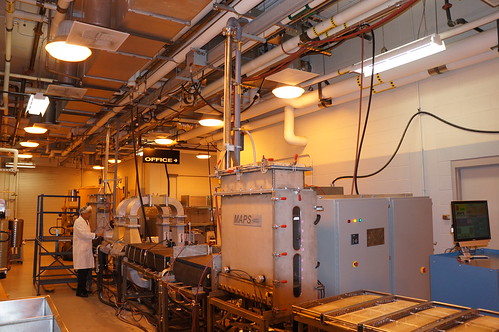
A Washington State University-led research team member works on the prototype microwave assisted pasteurization system (MAPS) unit. MAPS allows packaged foods to be safely processed more quickly and at lower cost than conventional processes. Photo courtesy of Washington State University.
During the month of April we will take a closer look at USDA’s Groundbreaking Research for a Revitalized Rural America, highlighting ways USDA researchers are improving the lives of Americans in ways you might never imagine, like innovative ways to make food safer.
More than 90 percent of American households have microwave ovens where people heat their food, yet this same technology is seldom used for large-scale production in the food industry.
As home cooks know, microwave ovens do not excel at heating food evenly. The lack of commercial-scale microwave processing technology is, in part, due to the challenge of designing equipment that is capable of pasteurization – heating all of the food evenly to a predetermined temperature for a certain length of time. Pasteurization makes food safe to eat, by inactivating bacterial and viral pathogens that can make people sick.
Food safety is the top priority for the food industry and has long been one of the priority research areas for the U.S. Department of Agriculture’s National Institute of Food and Agriculture (NIFA). With the help of a $5 million grant from NIFA, a team of scientists and engineers led by Washington State University (WSU) have developed an innovative, pilot-scale microwave assisted pasteurization system (MAPS) to rapidly and evenly heat packaged food products. The team included University of Tennessee, North Carolina State University, the U.S. Army Soldier Systems Center, and USDA’s Agricultural Research Service Eastern Regional Research Center.
The prototype is a 915 MHz microwave that processes foods that are both safe and of high quality. Initial results show that the quality of microwave-pasteurized foods, such as mussels, shrimp, and tofu, is better than using conventional thermal processing methods.
An additional benefit to this technology is that microwave heating time is shorter than conventional thermal processing, and the shorter time means producing higher food quality at lower energy output and cost.
Food companies can now use MAPS to test a wide range of food products and adapt the technology to suit their needs. WSU anticipates licensing this technology to a start-up company, Food Chain Safety, for commercialization in the coming months.
Through federal funding and leadership for research, education, and extension programs, NIFA focuses on investing in science and solving critical issues that impact people’s daily lives and the nation’s future. More information is available at www.nifa.usda.gov.
No comments:
Post a Comment